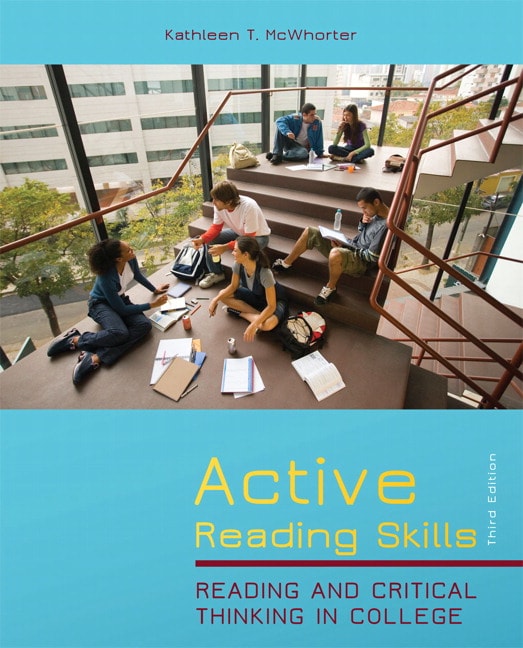
30.00$ - Purchase this E-book
Category : Higher Education
PART ONE: COLLEGE READING SKILLS Chapter 1: READING COLLEGE TEXTBOOKS: AN ACTIVE APPROACH Keys to Academic Success Control External Distractions Increase Your Attention Span Read and Learn Actively Preview Before Reading How to Preview Demonstration of Previewing Making Predictions Use Guide Questions Textbook Reading Skills Textbook Learning Aids The SQ3R Reading/Study Method Learning/Recall Strategies An Introduction to Critical Thinking The Textbook Challenge: Reading in Communication/Speech Disciplines: Kinesics Chapter Summary Self-Test Practice Test 1 Practice Test 2 Mastery Test 1 Mastery Test 2 Mastery Test 3: Diversity in U.S. Families (Textbook Excerpt) What is Context? Types of Context Clues Definition Clues Synonym Clues Example Clues Contrast Clues Inference Clues What Are Word Parts? Prefixes Roots Suffixes Thinking Critically About Vocabulary Textbook Challenge: Reading in Science Disciplines: What Causes Extinction? Chapter Summary Self-Test Practice Test 1 Practice Test 2 Mastery Test 1 Mastery Test 2 Mastery Test 3: Greenwashing Why Are Main Ideas Important? Distinguishing Between General and Specific Ideas Locating the Topic Locating the Main Idea Tips for Finding the Main Idea Tips for Locating the Topic Sentence Locating the Central Thought Thinking Critically About Main Ideas Textbook Challenge: Reading in Business Disciplines: Guerrilla Marketing Chapter Summary Self-Test Practice Test 1 Practice Test 2 Mastery Test 1 Mastery Test 2 Mastery Test 3: Stop Asking Me My Major Chapter 4: EXAMINING DETAILS AND TRANSITIONS Why Are Supporting Details Important? UsingTransitions Thinking Critically About: Details Textbook Challenge: Reading in Career Fields: Fear of Crime Chapter Summary Self-Test Practice Test 1 Practice Test 2 Mastery Test 1 Mastery Test 2 Mastery Test 3: Talking A Stranger Through the Night Chapter 5: WORKING WITH IMPLIED MAIN IDEAS What Does Implied Mean? Distinguishing Between General and Specific Ideas Identifying Implied Main Ideas in Paragraphs Finding Implied Main Ideas in Visuals Thinking Critically About: Details Textbook Challenge: Reading in the Social Sciences: Who Should Live and Who Should Die? The Dilemma of Rationing Medical Care Chapter Summary Self-Test Practice Test 1 Practice Test 2 Mastery Test 1 Mastery Test 2 Mastery Test 3: Friendship for Guys (No Tears!) Chapter 6: ORGANIZING INFORMATION Why Keep Track of Information? Highlighting and Marking Highlighting Effectively Marking to Record Ideas Outlining Mapping Summarizing Good Reasons to Keep Track Of Information Thinking Critically About: Keeping Track of Information Textbook Challenge: Reading in Health Fields: Gender Differences and Health Chapter Summary Self-Test Practice Test 1 Practice Test 2 Mastery Test 1 Mastery Test 2 Mastery Test 3: Employee Speech in the Digital Age Chapter 7: EXAMINING BASIC PATTERNS OR ORGANIZATION What Are Patterns of Organization? Example Definition Combining Definition and Example Chronological Order and Process Listing Thinking Critically About the Example Pattern Textbook Challenge: Reading Literature: What is Fiction? (includes a short short , "A Gentleman's C" by Padgett Powell) Chapter Summary Self-Test Practice Test 1 Practice Test 2 Mastery Test 1 Mastery Test 2 Mastery Test 3: Animals at Play (Textbook Excerpt) Chapter 8: EXAMINING COMPARISON/CONTRAST AND CAUSE/EFFECT PATTERNS Comparison/Contrast Patterns Contrast Using Both Comparison and Contrast Cause and Effect Patterns Other Useful Patterns Classification Statement and Clarification Summary Addition Spatial Order Thinking Critically About Comparison/Contrast and Cause/Effect Textbook Challenge: Reading History: Whether to Vote: A Citizen's First Choice Chapter Summary Self-Test Practice Test 1 Practice Test 2 Mastery Test 1 Mastery Test 2 Mastery Test 3: Global Warming PART TWO: CRITICAL READING SKILLS Chapter 9: MAKING INFERENCES AND ANALYZING THE AUTHOR’S PURPOSE What Is Inference? How to Make Inferences Making Inferences about Graphics Understanding Author’s Purpose Considering Style and Intended Audience Analyzing Language: Denotation and Connotation Critical Thinking Challenge: Reading Blogs: Green Exercise Better Than Just Plain Exercise Chapter Summary Self-Test Practice Test 1 Practice Test 2 Mastery Test 1 Mastery Test 2 Mastery Test 3: Boots on the Ground: A Day in the Life of a Border Sheriff Chapter 10: DISTINGUISHING FACT FROM OPINION Fact Opinion Judgment Words Mixing Fact and Opinion Evaluating Fact and Opinion Recognizing Informed Opinion The Critical Thinking Challenge: Reading Newspapers: College Apologizes After Instructor Says Spanish Can't Be Spoken in Class Chapter Summary Self-Test Practice Test 1 Practice Test 2 Mastery Test 1 Mastery Test 2 Mastery Test 3: Therapy Dogs Chapter 11: ANALYZING TONE AND BIAS RecognizingTone Tone and Connotative Meanings Identifying Tone Tone: The Relationship Between the Writer and Reader Understanding Irony and Sarcasm Analyzing Bias What is Bias? How to Detect Bias The Critical Thinking Challenge: Reading Magazine Articles: Fear Itself Chapter Summary Self-Test Practice Test 1 Practice Test 2 Mastery Test 1 Mastery Test 2 Mastery Test 3: Love on the Internet and Video Dating (Textbook Excerpt) Chapter 12: READING ARGUMENTS What is an Argument? Parts of an Argument The Issue The Claim The Support Questions for EvaluatingArguments Is the Evidence Relevant? Is the Evidence Sufficient? Does the Author Use Emotional Appeals and Are They Used Unfairly? Errors in Logical Reasoning Circular Reasoning Hasty Generalization Non Sequitur False Cause Either-Or Fallacy Arguments in Academic Writing The Critical Thinking Challenge: Reading Editorials: Our View on Your Health: What Can Be Done to Shake America's Salt Habit? Chapter Summary Self-Test Practice Test 1 Practice Test 2 Mastery Test 1 Mastery Test 2 Mastery Test 3: Don’t Panic PART THREE: STUDENT RESOURCE GUIDE Appendix A: Exit Exams and Comptency Tests Appendix B: Evaluating Internet Sources Table of Contents
Get Active Reading Skills: Reading and Critical Thinking in College, 3rd Edition by Kathleen T. McWhorter, Niagara County Community College Brette M Sember, Niagara County Community College


0 commentaires:
Enregistrer un commentaire